Abstract: To understand intra-household decision making, the study considers participation in decision making on rice farming by an individual. It employed data obtained from a face-face questionnaire interview from farming households. The data were collected between July and September, 2019 cropping season. The questionnaire contained data on socio-economic/demographic and decision making on rice production; sales and finance within the households. Multi-stage sampling procedure was used in the selection of respondents from the study area. The data were analyzed using descriptive statistics, T-test and Tobit regression model. Empirical results revealed that female farmers are disadvantaged in the access to economic resources. There is a statistically significant difference in decision making among female and male farmers. It was found out that male farmers solely make most decisions on rice production and revenue while the female farmers tend to have more control on marketing of produce. Age of the farmer, non-farm activity participation, land ownership and access to credit significantly increased female farmers’ decision making power. Access to economic resources especially credit facilities, land and information were the major constraints female farmers face in developing their capabilities as farmers. The study suggests that market intervention will advance women’s position and performance in agricultural sector. Closing the gender gap in decision making will enhance the creation of conducive economic environment in the Nigerian rice sector.
Keywords: Gender, decision, intra-households, family farm, Southwest Nigeria.
Resumo: Para compreender a tomada de decisão intrafamiliar, o estudo considera a participação individual na tomada de decisão sobre o cultivo do arroz. Neste estudo, empregamos dados obtidos a partir de uma entrevista por questionário presencial a famílias de agricultores. Os dados foram coletados entre julho e setembro, safra 2019. O questionário continha dados socioeconômicos / demográficos e tomada de decisão na produção de arroz; vendas e finanças dentro das famílias. O procedimento de amostragem em múltiplos estágios foi utilizado na seleção dos respondentes da área de estudo. Os dados foram analisados por meio de estatística descritiva, teste T e modelo de regressão Tobit. Os resultados empíricos revelaram que as mulheres agricultoras estão em desvantagem no acesso aos recursos econômicos. Há uma diferença estatisticamente significativa na tomada de decisão entre agricultores e agricultoras. Foi descoberto que os agricultores do sexo masculino são os únicos que tomam a maioria das decisões sobre a produção e a receita do arroz, enquanto as agricultoras tendem a ter mais controle sobre a comercialização da produção. A idade do agricultor, a participação em atividades não agrícolas, a propriedade da terra e o acesso ao crédito aumentaram significativamente o poder de decisão das agricultoras. O acesso a recursos econômicos, especialmente facilidades de crédito, terra e informações, são as principais restrições que as mulheres agricultoras enfrentam no desenvolvimento de suas capacidades como agricultoras. O estudo sugere que a intervenção no mercado irá melhorar a posição e o desempenho das mulheres no setor agrícola. Eliminar a lacuna de gênero na tomada de decisões aumentará a criação de um ambiente econômico favorável no setor de arroz nigeriano.
Palavras-chave: gênero, decisão, intra-domiciliar, agricultura familiar, Sudoeste da Nigéria.
Artigos
Women’s involvement in intra-household decision making on agricultural production: what factors matter?
Envolvimento das mulheres nas decisões dentro do domicílio na produção agrícola: quais fatores importam?
Received: 08 June 2021
Accepted: 01 September 2021
Agriculture remains a key sector for economic growth accounting for 4% of global Gross Domestic Products (GDP) and around 9.5% of GDP for all developing countries (World Bank (WB), 2018). It is the main source of livelihood for Africans and majority of the farmers are smallholders, who provide 80 percent of the food supply (WB, 2015; AGRA, 2017). The Sub-Saharan Africa (SSA) has the highest percentage of the population employed in the agricultural sector. However, despite the available natural resources, findings reveal that SSA records the lowest agricultural productivity as measured by cereals per hectare (WB, 2019). The low productivity is caused by gender discrimination among other factors such as erratic policies, low government spending on agriculture, inadequate inputs, limited access to land, lack of access to credit, low adoption of improved technology, lack of access to agricultural information, low irrigation, conflicts and climate change (Deininger and Byerlee, 2011; Sheahan and Barrett, 2014; WB, 2019).
Gender is progressively becoming an important area of focus in agricultural research, in order to enhance inclusivity and fairness in resource allocation and sharing of farm benefits. In SSA, roughly 50% of the agricultural workers are women (WB, 2019). However, men and women face unequal access to resources especially in the rural areas (Kilic et al., 2013; Croppenstedt et al., 2013). According to Agarwal (2015) and Kassie et al., (2015), there is gender inequality in access to assets, land, technology, extension services and financial services. Women encounter challenges in accessing high value markets and other key services required in agricultural production such as extension and membership in cooperatives (Kilic et al., 2013; Croppenstedt et al., 2013; Njuki et al., 2014; Mukasa and Salami, 2015). Agarwal (2015) has shown that women generally do not own the land they farm. As a result of low access to economic resources, women record lower productivity and efficiency in agriculture than men, leading to gender gap in agricultural production (Njuki et al., 2014). Doss (2014) argues that women could be as productive as male farmers if given similar opportunities and access to equal resources.
Hence, there is a need to close the gender gap in agriculture in order ensure food security for a population that is not only growing but also becoming more urbanized (Doss, 2014). According to UN (2015), closing gender gap could increase agricultural productivity by 20 to 30 percent in SSA. It can also culminate in additional benefits such as raising the incomes of female farmers, increasing the amount of food produced, improving nutrition and alleviation of poverty. Kassie et al. (2015) posits that enhancing women’s empowerment by improving their decision making ability and allowing them to take advantage of opportunities is crucial to agricultural development and poverty reduction in low-income countries.
Rice is Africa’s largest and fastest-growing import. It has replaced traditional staples for most urban consumers because of its storability and ease of preparation (FAO and African Development Bank, 2015). According to FAO (2015), Nigeria is Africa’s leading consumer of rice. The demand for rice in Nigeria has outpaced domestic production due to rapid population growth and urbanization (FAO, 2015). As asserted by USDA (2016), the annual consumption of rice in Nigeria was about 5million Metric Tonnes (MT) while quantity produced was 2.7 million MT. This gives a demand-supply gap of roughly 2.3 million MT, which is being filled by importation. However, with the bans on importation of rice, there is a need to increase domestic production. In order to transform the Nigerian rice sector, it is imperative to take into consideration gender disparities in access to agricultural production resources and decision making in the farming households. This will be helpful in protecting the interest of women in agriculture. It will also contribute to significant impacts of policy interventions on households’ and national food security (Todaro and Smith, 2012;Akter et al., 2017).
Though, there are several studies on Nigerian rice sector, such as Fakoyede et al. (2010), Bamidele et al. (2010) (rice consumption and production), Dontsop-Nguezet et al. (2013), Awotide et al. (2013) (rice improved technology adoption), Ayinde et al. (2013), Amaechina and Eboh (2017) (technical and resource use efficiency). However, there are scanty empirical studies on gender analysis of decision making among Nigerian rice farming households. Few studies such as Rahman (2008) and Ajewole et al. (2015), established that there are gender differences in decision making among farming households in Northern Nigeria. However, there is still a dearth of study on decision making and the influencing factors among farming households especially in southern part of Nigeria. Therefore, this study contributes to the debate on gender mainstreaming by providing more empirical evidences on gender disparities and factors that could enhance decision making power of women in the Nigerian agricultural sector. The study proffers answers to the following research questions: What is the level of decision making of men and women in rice production, finance and marketing? What are the factors that influence women’s decision making power in agriculture? Lastly, what are the various constraints encountered in rice farming in the study area?
The study was conducted in Ekiti State, Southwest Nigeria. Ekiti State is characterized by the tropical climate with two distinct seasons. Rainy season is between April and October while the dry season is between November and April. Temperature ranges between 21oC and 28oC. Ekiti state has tropical rain forest vegetation in the South and savannah vegetation in the Northern fringes. The main occupation of the people of Ekiti State is farming. Crops grown in the state include cocoyam, yam, rice, cassava, plantain, maize, oil palm, beans, fruits and vegetables. The state has a great potential in rice production.
Multi-stage sampling procedure was used in the selection of respondents from the study area. The first stage involved the purposive selection of two Local Government Areas (LGAs) known for rice production in Ekiti state, Southwest, Nigeria. In the second stage, three (3) communities where rice production is dominant were purposively selected from the LGAs while the third stage involved random selection of twenty households from each of the selected communities using community households’ roster. This gave a total of one hundred and twenty (120) rice farming households. However, husbands and wives were interviewed in male-headed households while female farmers only were interviewed in female-headed households.
Primary data were used for this study. The primary data were collected through the use of a structured questionnaire. Data were collected on socio-economic characteristics of the respondents, intra-household decisions making on rice production, sales and finance as well as the constraints encountered in rice farming. The data were analyzed using descriptive statistics, t-test and Tobit regression model. Descriptive statistics was used to profile the socio-economic characteristics of the respondents and to estimate their decision making levels. Decision making ranked score was computed for each of the respondents based on their participation in decision making. A score of zero was allocated to no participation, one to sole decision making and 0.5 for joint decision. Decision making index was generated for the individual farmer as follows:
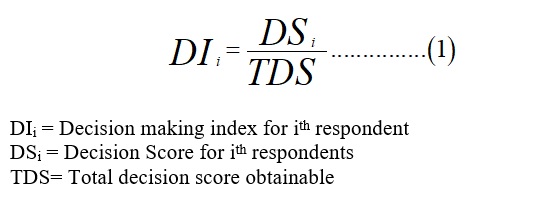
Tobit regression model was used to analyze factors influencing women’s decision making power. Following Maddala (1992), Johnston and Dandiro (1997) and Negash (2007), the Tobit model for the continuous variable decision level can be expressed as:
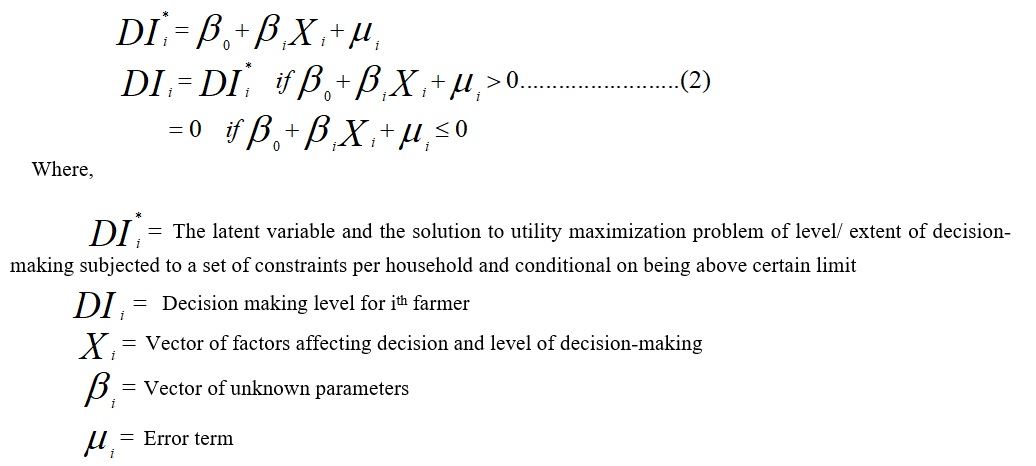
The explanatory variables included in the model are:
X1= Age (years)
X2= Household Size (Numbers of persons)
X3= Year of Formal Education
X4= Household headship (Male=1, Female =0)
X5= Farm Size (Hectares)
X6= Non-farm income activity (1= Yes, No =0)
X7= Land ownership (1= Yes, No =0)
X8= Access to Extension services. (1= Yes, No =0)
X9= Access to credit (1= Yes, No =0)
X10 =Years of farming experience (in years)
X11 =Membership of co-operative societies (1= Yes, No =0)
X12 = Crop yield (tonnes/hectare)
X13 = Farm income (Naira)
The descriptive analysis reveals that majority (77.17%) of the household heads are male (Table 1). The mean age of the respondents was 53years with an average of 19 years of rice farming experience. The years of farming experience of male farmers was about 3 years higher than their female counterparts. Most of the rice farmers had formal education. There is no significant difference between the years of education of female farmers and male farmers. All the farmers are smallholders. The farm size of male farmers was significantly higher than female’s as shown in Table 1. This affirms that male farmers have more access to land than female farmers. This will have implications on their productivity. Considering land ownership, about 59% of the farmers are land-owners. A significantly higher proportion of male farmers owned their farmland compared to female farmers. Like most African countries, women lack independent land rights in Nigeria (Kabane, 2015). In the same vein, there is a significant difference in credit access between male farmers and female farmers. This is in line with Mtsor and Idisi (2014) that there is gender difference in access to credit among Nigerian farmers. From the results, female farmers are disadvantaged with only 48% having access to credit compared to 94.74% of their male counterparts. On the contrary, larger percentage of the female farmers (90.0%) cultivates improved varieties compared to 86.02% of the male farmers. This implies that female rice farmers are likely to be better adopters of agricultural innovations than male rice farmers. Interestingly, all the famers are members of farmers’ association. Furthermore, the results reveal that access to extension agents is generally poor among respondents. This supports the need for improvement in extension services in Nigeria.
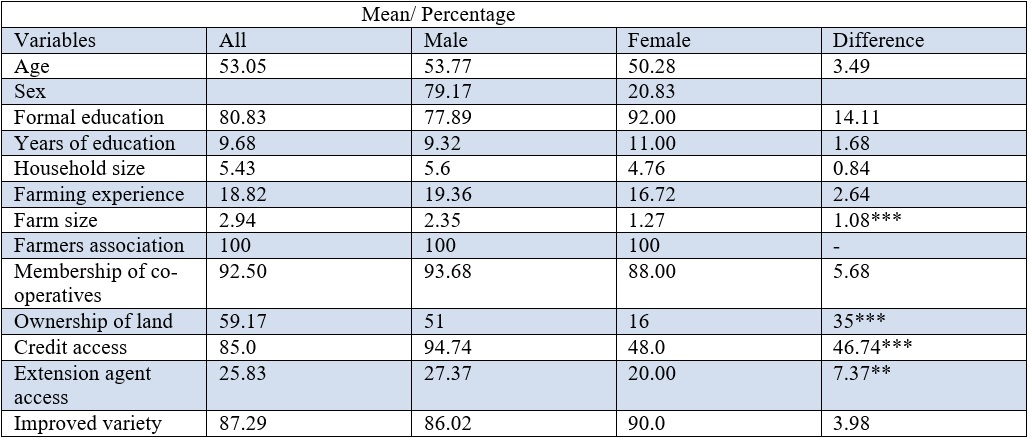
The intra-household decision making is presented in Table 2. The intra-household decision making pattern was used in this study as a proxy for individual’s control over resources within the household. It could also indicate gender economic empowerment within the household. This is based on agricultural production (who decides on: land acquisition, land improvement, labour to be used, time to plant, crops grown, inputs to be used, where to get inputs, payment for inputs, use of fertilizer, the type of fertilizer to purchase and type of varieties to grow); finance (source of credit, use of obtained credit, keeping of revenue and utilization of revenue; marketing (selling price, quantity to sell, quantity to consume and when to sell). The empirical results show that many of the decisions are solely taken by male farmers. This indicates that men have more control over agricultural resources than women, irrespective of either they are plot managers or not. This is in line with Ajewole et al. (2015) and Ednah and Sichilima (2016) which posited that most decisions on agricultural production were solely made by the male farmers in northern Nigeria and Zambia respectively. From the results, 59.2% of male farmers solely decide on land acquisition compared to 20.0% of female farmers, while 20.8% of the respondents jointly make decisions on land acquisition in the households. This implies that male farmers had more control over land acquisition than female farmers. This is due to socio-cultural factors that confer land rights to men. In Nigeria, men are always in charge of land acquisition and ownership. Similarly, male farmers dominates decision making on land improvement, labor, crops grown, input used, types of variety to grow, fertilizer use etc. (Table 2).
Female farmers made more sole decisions than male farmers on the quantity to sell, quantity to consume and when to sell. This is consistent with Ednah and Sichilima (2016) findings that female farmers are more involved in marketing of agricultural produce in Zambia. Hence, women empowerment projects or programmes could be tailored towards market access. Furthermore, decisions on credit source and use as well as utilization of farm revenue are solely made by male farmers. This reveals that despite women’s access to income generating activities, majority of the female farmers are denied the opportunity to solely decide on the use of their earned income.
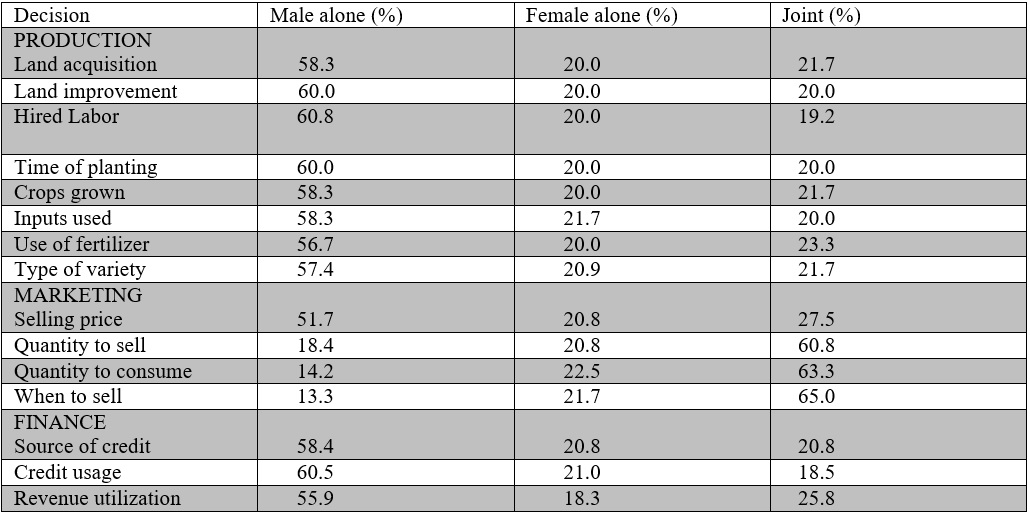
The study further estimates the decision making level of the farmers. This serves as a proxy for intensity of control over economic resources by the farmers. This was generated using the farmers’ decision making ranked scores. A score of zero was allocated to no participation, one to sole decision-making and 0.5 for joint decision. The mean decision making index of male farmers was significantly (P< 0.01) higher than that of female farmers by 0.26 as shown in Table 3. This corroborates the fact that female farmers have less control over agricultural resources and revenue in Nigeria.

The results of the Tobit regression model on the factors influencing decision making of female farmers is presented in Table 4. The result of the Tobit regression model shows that age, having male household head, household size, non-farm income activity, land ownership and access to credit significantly influenced decision making index of female farmers. The age of the farmer has a significant and positive influence on female farmers’ decision making index. Older female plot managers are likely to have more decision making power over agricultural resources and revenue than younger ones. From the result, age of the farmer significantly increased decision making level by 1.32%. This result is in agreement with Peterman et al. (2015) which found that age significantly influenced female decision making in Uganda and Pakistan respectively. A unit increase in household size will decrease the decision making level significantly (p<0.05) by 8.78%. This implies that the smaller the household size, the higher the female decision making power. This contradicts Sell and Minot (2015) which argues that household size had no significant influence on women’s empowerment.
Having a male household head negatively influences female decision making. From the results, male household headship decreases decision making level of a female farmer significantly (p<0.05) by 69.17%. Male household head dominates decision making even if the woman is the plot manager. The findings agrees with Baliyan (2014) and Ednah and Sichilima (2016) which posit that household headship significantly influenced women’s decision making in Pakistan and Zambia respectively. Furthermore, access to credit has positive and significant influence (p<0.05) on the decision making power of female farmers. From the result of this study, access to credit facilities leads to 28.31% increase in the decision making level. Access to credit empowers female farmers and increases their capability to access economic resources.
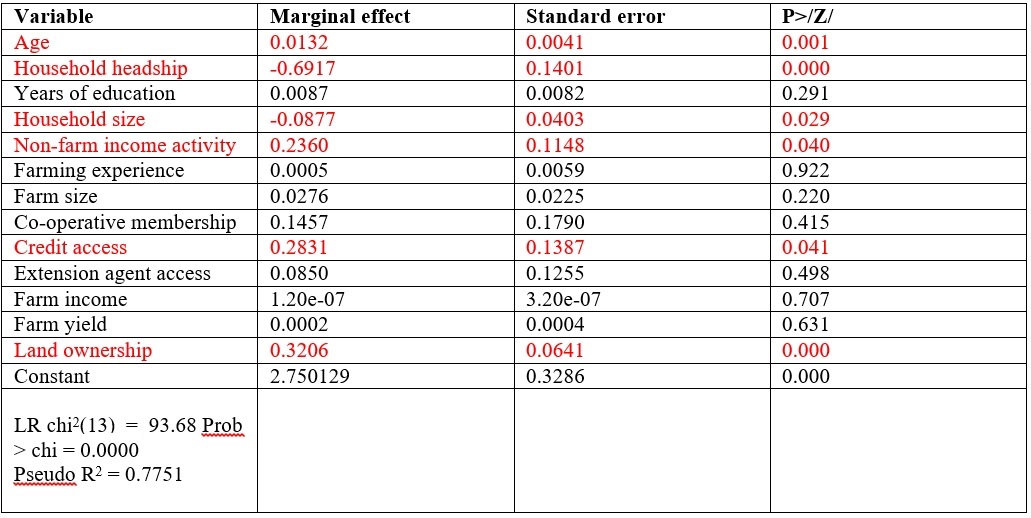
The constraints encountered by farmers in rice production in the study area are presented in Table 5. The major constraints were ranked based on the priority of the farmers. For male farmers, lack of access to farm machineries ranked first while high cost agricultural inputs, inadequate credit, and poor extension services ranked second, third and fourth respectively. To the female respondents, inadequate credit was the major constraint. Other constraints were high labor cost, lack of information on climate variation and poor extension services. Interventions on these factors have the potential of improving rice production and welfare of rice farmers in Nigeria. However, agricultural and rural development interventions should be gender responsive.
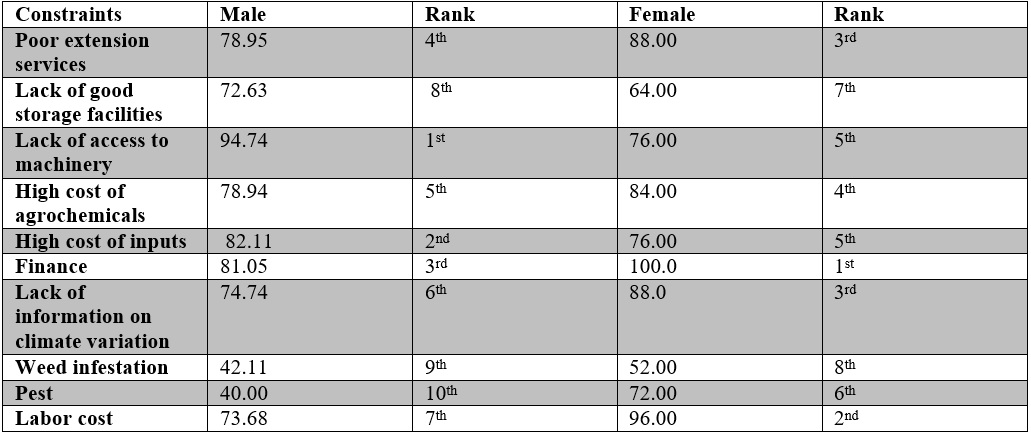
The study considered the involvement of women in intra-household decision-making and the influencing factors. It revealed that women are disadvantaged in the access to economic resources and men dominate decision making in rice farming in the study area. Female farmers are more involved in decisions relating to marketing of produce. This implies that market-oriented policy interventions will enhance women’s empowerment and increase their capability to take advantage of opportunities. Socio-economic variables such as credit access, age, household size, non-farm income activity, land ownership and household headship significantly influenced female farmers’ decision making power. Lack of access to economic resources especially credit facilities and land are major constraints women face in developing their capabilities as farmers. The study concludes that there is need to close gender gap in decision making in order to create conducive economic environment in the Nigerian rice sector. Therefore, agricultural, rural development and empowerment programmes should not be gender blind.






